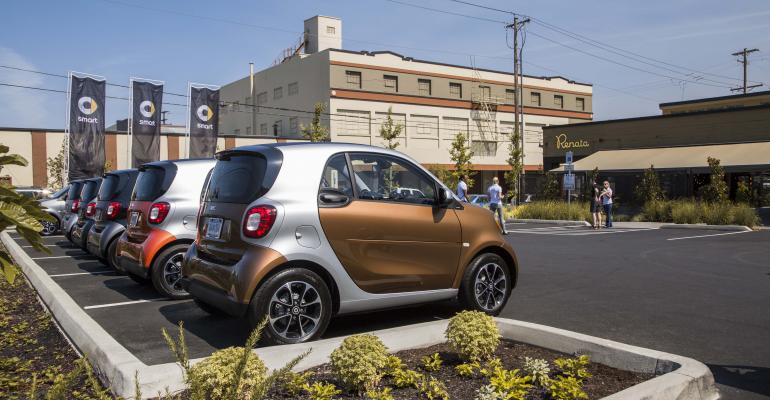PORTLAND, OR – When the Smart Fortwo micro car came to America in 2008, the head of its U.S. unit proclaimed it was for “Gen E – Generation Everyone.”
But the little car that supposedly could drew little interest from Americans who tend to like their ride on the high-tide side. Ripples followed a first wave of buyers. Even those who eyed the 2-seater as “aww-shucks” cute wouldn’t actually put it on their shopping list.
Now parent company Daimler is introducing to the U.S. a redone and enhanced ’16 Fortwo, arriving at dealerships later this month. But Daimler has nixed the for-all strategy.
“This is a specific car for specific customers in specific cities,” says company spokesman Christian Bokich at a media preview in this city, one of those designated target markets.
Outlier suburbanites can keep their SUVs. Wyoming ranchers can hang on to their pickups. The rear-wheel-drive Smart is for city folk in tight-driving places such as Portland, San Diego, San Francisco, Paris and Rome where “the streets aren’t getting any wider and they’re not going to tear down any buildings to make them wider,” Bokich says.
The ’16 model is 4 inches (10.6 cm) wider to give it a more planted look, offer more stability and provide more interior elbow room. But the length of 8.8-ft (2.7 m) is unchanged.
“It was the shortest car on the market and remains that,” says spokesman Willem Spelten. “The unique selling proposition is its shortness.”
That allows for zipping in and out of urban traffic, squeezing into tight parking spots and making crisp U-turns.
“The engineers are proud they kept the length the same,” says Heiko Schmidt, the brand’s department manager-product management. “It’s an ideal city car for urban jungles.”
The engine, now provided by Renault rather than Mitsubishi, stays astern in another city-friendly product-development call.
“In the planning phase, we were clear we wanted to retain the rear engine so as to continue to exploit the vehicle’s strength to the fullest in the city,” says Jorg Prigl, head of the product group Compact Cars at Mercedes-Benz, Smart’s sister brand.
The ForTwo’s 3-cyl. engine is fit for a minicar. It is 0.9L, turbocharged and hits 89 hp at 6,200 rpm. Top speed: 96 mph (153 km/h). Fuel economy: TBA.
Accelerating 0-60 mph in about 10 seconds, it will hold its own on a freeway entrance ramp, but won’t win drag races. “It’s not supposed to be a sports car,” Schmidt says.
A new dual-clutch 6-speed automatic transmission makes shifting smoother in contrast with the prior model’s notorious gear-to-gear lurching. The head-bobber transmission in the earlier model “was not what you hoped for,” Spelten says.
The new car’s base price is $14,650. There are four trim models compared with three in the outgoing model. Daimler will unveil a convertible at the Frankfurt auto show.
Smart sold 10,453 Fortwos in the U.S. last year, according to WardsAuto data. That hurts compared with sales of 24,622 in 2008. After that launch year, deliveries declined. The disturbing low point fell to deliveries of 5,208 units in 2011, a bad year for the auto industry overall.
“We’d like to see U.S. sales go higher,” Schmidt says. Competitors include the Mini, Fiat 500 and Mitsubishi Mirage, he says, adding he was “happy to see the Scion IQ go away” as a 2-door competitor.
Daimler has signed up the Fortwo for ride-sharing programs in 16 U.S. cities, including Portland, Miami and Los Angeles. The automaker sees the little guy as perfect for that role.
Smart began in 1994 as a joint venture between what was then Daimler-Benz and Swatch, a Swiss watch company that was out of the picture when the Fortwo debuted in Europe in 1998 and a decade later in the U.S.
Daimler has lost money on the Smart, one reason it has partnered with French automaker Renault on product development and parts sharing for the ’16 Fortwo that is made in France.
A separate version of the car is sold as the Renault Twingo elsewhere in the world. Renault makes a 4-door version, but don’t expect to see such a Smart soon in the U.S.
“There would need to be several modifications to comply with U.S. law for the 4-door Smart to be sold in America,” Spelten, referring to crash-test standards, tells WardsAuto. “And the segment in the U.S. is so small, it’s better to have one car rather than two.”
To a degree, Smart and Mercedes-Benz engineers collaborated on the new Fortwo. For instance, a cross-wind stabilizer stems from Mercedes technology. But overall the two brands keep their distance.
“You are not going to see anyone give up their Mercedes to get into a Smart,” Schmidt says.
The Smart is sold at 89 Mercedes dealerships in the U.S. Mercedes’ luxury-brand strength rubs off a bit on the down-market Smart. “It reinforces buyer confidence,” says Janice Tucker, department manager-Smart.
Daimler at first sold Smarts as a 1-car dealership offering in the U.S. through a retail network run by megadealer Roger Penske. That set up ended in 2011.





